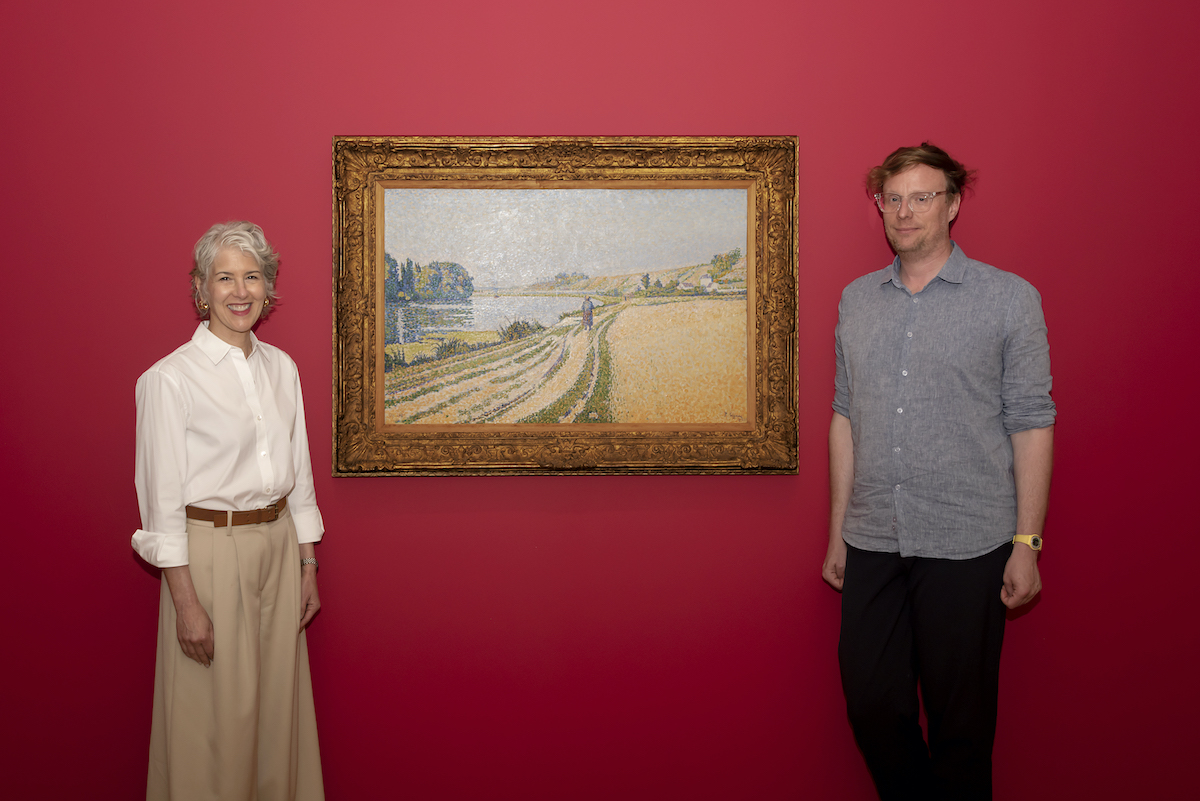Lady Leslie and Lord Paul Ridley-Tree’s Art Collection at the SBMA

The artworks from the collection of Paul and Leslie Ridley-Tree will be honorably on view in the Santa Barbara Museum of Art’s McCormick Gallery, July 7 through November 3. The exhibition is titled A Legacy of Giving: The Lady Leslie and Lord Paul Ridley-Tree Collection.
During installation week, I interviewed the exhibit’s curator, James Glisson, who is the SBMA Curator of Contemporary Art. Glisson holds a PhD from Northwestern University with a focus in 19th century art. His projects have been covered by The Guardian, Los Angeles Times, El País (Madrid), the Wall Street Journal, and the Los Angeles Review of Books.
Also present was the SBMA Eichholz Foundation Director Amada Cruz, who shared, “Over 30 years, Lady and Lord Ridley-Tree gave more than 50 artworks to the Museum with the aim of expanding on the already renowned collection of 19th-century French and English works. Lady Ridley-Tree knew the Museum’s collection well, and she acquired works to build on these existing strengths. Thanks to their generosity, we now have a fourth Monet, two works by the famed pre-Raphaelite Dante Gabriel Rossetti, a touching portrait of young girl by the Impressionist Berthe Morisot, and a pastel by Mary Cassatt. The exhibition’s lead image is a painting by the renowned Pointillist Paul Signac. These are outstanding paintings by some of the most famous artists of the 19th century. Since Lady Ridley-Tree often entertained at her home, her art collection was well-known in the community. There has been curiosity about when the Museum would share these treasures, and we did not want to wait to celebrate such an important gift.”
As we walked around the exhibit, Glisson explained the importance of the artworks as a whole, “Art is a way to connect people and ideas, to enliven our imaginations. The focus should be how these 19th century paintings tell us about the past, and a view into our own moment, as educational windows. That is most appropriate for how Leslie wanted these artworks to be used, her deep belief in education’s transformative potential. The artists from 150 years ago are talking about problems and life experiences that are similar to what we see today,” Glisson continued. “I selected five themes for the exhibit:
“Brand Management Circa 1870 – Gustave Courbet and Narcisse Díaz de la Pena knew what social media influencers bank on today, negative publicity is still publicity, the inherent quality of a commercial product or an artwork is not necessarily enough to make it successful.
“Factories and Farms– The agrarian paintings are a way of avoiding city life, city growth, pollution, and plagues, so we don’t see any factories in them. Claude Monet’s Afternoon on the Seine (1897), is particularly representative, as the Seine River was very polluted being downstream from Paris.”
“Forging A Career – Thanks to these gifts, we are able to represent two women artists – Mary Cassatt and Berthe Morisot – who were essential to the Impressionist Movement and Revolution, and we are able to tell the story of how both of them managed to have careers despite cultures and societies that did not want to support women artists.
“Barbizon – via Henri-Joseph Harpignies, Theodore Rousseau, Camille Pissarro, and Eugene Boudin’s paintings – is one of the very first documented incidents of people advocating for environmental preservation. The artists were upset the forests they were painting were being logged. They went to the government and petitioned. Parts of the forests were set aside, and the trees were allowed to age without intervention. The artists were interested in, and painted, the forest’s life cycle after a lot of trees had died, were raw and bald.
“History and Fantasy – Dante Gabriel Rossetti, Henri Fantin-Latour, and Walter John Knewstub artworks are more representative of 19th c. art, that is, mythological and historical subjects, imposed stereotypes of femininity, looking at the past and imaging the future, and fashion, which is presenting the best version of yourself.”
I asked Glisson about the contextual element of the works, utilizing his prior work in 19th century art and his work as a Curator of Contemporary Art. He expressed his belief that, “All curators have a responsibility to be true to the objects and the artists we are engaging with, but we also have to think in creative ways how that might relate to audiences or contemporary issues. When I approached this material, I noticed a lot of landscapes, knew the history of them in the 19th century and how we can relate to it now, and it went from there. Curators create a space where people can identify and find relevance and make some associations – I hope – if I’m successful.”
Indeed, from the red painted walls the art is installed upon (in honor of red being Leslie Ridley-Tree’s favorite color) to the themed curation, the exhibit is worthy of local and national laude. A few visits to view the art, and the planned collaborative events with the community partners, is highly recommended. Check the 411 for details.
411: www.sbma.net/legacy






